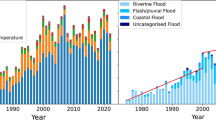Abstract:
Since the introduction into flood risk analysis, the partial duration series method has gained increasing acceptance as an appealing alternative to the annual maximum series method. However, when the base flow is low, there is clustering in the flood peak or flow volume point process. In this case, the general stochastic point process model is not suitable to risk analysis. Therefore, two types of models for flood risk analysis are derived on the basis of clustering stochastic point process theory in this paper. The most remarkable characteristic of these models is that the flood risk is considered directly within the time domain. The acceptability of different models are also discussed with the combination of the flood peak counted process in twenty years at Yichang station on the Yangtze river. The result shows that the two kinds of models are suitable ones for flood risk analysis, which are more flexible compared with the traditional flood risk models derived on the basis of annual maximum series method or the general stochastic point process theory.
Similar content being viewed by others
Author information
Authors and Affiliations
Additional information
Received: September 29, 1997
Rights and permissions
About this article
Cite this article
Xu, Z., Li, J. & Ito, K. Clustering stochastic point process model for flood risk analysis. Stochastic Hydrology and Hydraulics 12, 53–64 (1998). https://doi.org/10.1007/s004770050009
Issue Date:
DOI: https://doi.org/10.1007/s004770050009




